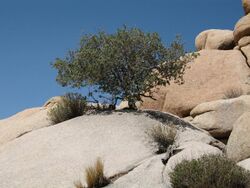Biology:Quercus cornelius-mulleri
| Muller's oak | |
|---|---|

| |
| Scientific classification | |
| Kingdom: | Plantae |
| Clade: | Tracheophytes |
| Clade: | Angiosperms |
| Clade: | Eudicots |
| Clade: | Rosids |
| Order: | Fagales |
| Family: | Fagaceae |
| Genus: | Quercus |
| Subgenus: | Quercus subg. Quercus |
| Section: | Quercus sect. Quercus |
| Species: | Q. cornelius-mulleri
|
| Binomial name | |
| Quercus cornelius-mulleri Nixon & K.P.Steele
| |

Quercus cornelius-mulleri is a North American species of oak known by the common name Muller oak, or Muller's oak. It was described to science in 1981 when it was segregated from the Quercus dumosa complex and found to warrant species status of its own.[3][4][5] It was named after ecologist Cornelius Herman Muller. It is native to southern California and Baja California, where it grows in chaparral, oak woodlands, and other habitat in foothills and mountains. It can most easily be observed in Joshua Tree National Park and in the woodlands along the western margins of the Colorado Desert in San Diego County, California.[6][7][8]
Description
Quercus cornelius-mulleri is a bushy shrub not exceeding 3 meters (10 feet) in height. It is densely branched, its tangled twigs gray, brown, or yellowish, fuzzy when new and becoming scaly with age.[8]
The evergreen leaves are leathery and thick. They are bicolored: dull gray or yellow-green and faintly hairy on the upper surfaces, and white and quite woolly on the undersides. The wool on the undersides of the leaves is made up of star-shaped leaf hairs that are fused into microscopic plates.[6] The leaf blades are oval with smooth or toothed edges, and measure 2.5 to 3.5 centimetres (1 to 1 1⁄2 inches) in length.[8]
The fruit is an acorn with a cap up to 2 cm (3⁄4 in) wide covered in light-colored scales and a cylindrical, round-ended nut up to 3 cm (1 1⁄4 in) long.[8]
References
- ↑ Kenny, L.; Wenzell , K. (2015). "Quercus cornelius-mulleri". IUCN Red List of Threatened Species 2015: e.T78811580A78811590. doi:10.2305/IUCN.UK.2015-4.RLTS.T78811580A78811590.en. https://www.iucnredlist.org/species/78811580/78811590. Retrieved 12 November 2021.
- ↑ "NatureServe Explorer 2.0". https://explorer.natureserve.org/Taxon/ELEMENT_GLOBAL.2.142784/Quercus_cornelius-mulleri.
- ↑ Nixon, K. C. and K. P. Steele. (1981). A new species of Quercus (Fagacaeae) from Southern California. Madroño 28 210.
- ↑ "Quercus cornelius-mulleri Nixon & K.P.Steele". World Checklist of Selected Plant Families (WCSP). Royal Botanic Gardens (Kew). http://www.theplantlist.org/tpl1.1/record/kew-172316.
- ↑ "Quercus cornelius-mulleri Nixon & K.P.Steele". International Plant Names Index (IPNI). Royal Botanic Gardens, Kew. https://www.ipni.org/n/215727-2.
- ↑ 6.0 6.1 Nixon, K. C. (2002). The Oak Biodiversity of California and Adjacent Regions. US Forest Service Gen. Tech. Report
- ↑ "Quercus cornelius-mulleri", Calflora: Information on California plants for education, research and conservation, with data contributed by public and private institutions and individuals, including the Consortium of California Herbaria, Berkeley, California: The Calflora Database, https://www.calflora.org/cgi-bin/species_query.cgi?where-calrecnum=6989
- ↑ 8.0 8.1 8.2 8.3 Nixon, Kevin C. (1997), "Quercus cornelius-mulleri", in Flora of North America Editorial Committee, Flora of North America North of Mexico (FNA), 3, New York and Oxford, http://www.efloras.org/florataxon.aspx?flora_id=1&taxon_id=233501020
External links
- United States Department of Agriculture Plants Profile: Quercus cornelius-mulleri
- photo of herbarium specimen at Missouri Botanical Garden, collected in California in San Diego County in 1980
Wikidata ☰ Q2710363 entry
 |



